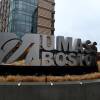Tuesday marks the 100th anniversary of the Great Molasses Flood in Boston. A 2 million gallon tank of molasses cracked open, and molasses covered two city blocks in just seconds, leading to 21 deaths and massive destruction. Historian and Boston University Adjunct Professor Anthony Sammarco joined Morning Edition Host Joe Mathieu to discuss the historical event. The transcript below has been edited for clarity.
Anthony Sammarco: This was a 2.3 million gallon tank of molasses. So if one could imagine, it was four stories in height, it was probably 150 feet across, and it was something that was adjacent to Commercial Street. So it was in a very densely populated, as well as active, area of the North End of Boston. So when this flood occurred, it not only created tidal waves, so to speak, of molasses that were 10 feet in height, but it was something that would have in some places close to two to three feet deep of sticky, brown molasses. ... [And] that evening it went below zero. And as a result, we saw much of the molasses freeze. So not only did we see humans, but even horses, and street life, of course, frozen in the sticky molasses for upwards of sometimes a week to two.
Joe Mathieu: Sounds like the La Brea Tar Pits or something here in Boston. There are stories of a tidal wave — you said a 10 foot wave — going 35 miles an hour, blasting through windows in people's homes.
Sammarco: Some houses were actually swept away. There were people that were adjacent to the staircase to the Copp's Hill Burial Ground. And in that instance on the right-hand side there was a family. They were simply sleeping, and they actually were swept away. And they did die. One actually survived for a few months but eventually did succumb. But the whole thing was, it wasn't just residential buildings that were built of wood that were destroyed. Even Engine 31, which was the Boston Fire Department's engine house, built of wood, was swept towards the river by the intensity of the molasses flood.
Mathieu: We should note this was not molasses for making baked beans. It was there to use for fuel.
Sammarco: Well, not only fuel, but United Purity Company, which was the owner of the company, actually used it for munitions. And during the period of World War I, molasses could either be used as a sweetening agent, or it could be used in this creation of munitions. There were all sorts of spurious types of conceptions at that time, that there were social revolutionaries that had actually exploded the gas tank and things of that sort. But it was really and truly the fact that, previous to dawn, it was actually below freezing. And by noontime, typical of Boston's weather in the winter, it was over 50 degrees. And it caused the molasses to somewhat heat, and the swelling of the molasses is supposed to have caused the seams of the molasses tank to burst.
Mathieu: And the rivets went flying out like bullets.
Sammarco: Exactly. It was never checked. And I think, basically, the city of Boston instituted in the 1920s a weight and seal department that actually would inspect these tanks. But the tank had never been inspected throughout the period of the teens of the 20th century. And many people in the North End would actually collect the molasses. It was something that was dripping from the seams. They'd use it in their cooking and all sorts of things. But in this period, it was something that created probably one of the most interesting stories of Boston's history and development.
Mathieu: We always hear as a part of this story that even 100 years later, on extremely hot days in the North End, you can still smell the molasses. That's not real, right?
Sammarco: Well, I think people want to believe it. I tried to re-experience this during my youth and I never could smell the molasses. But I think if we really want to believe it, we can smell it. And I think sometimes that's something that's really part of the history. Children love this story. It's become part of this lore of Boston. Is it true or is it not true?
Mathieu: You're not going to tell me it was the Necco plant or something they were smelling in that part of town?
Sammarco: I hope not. But the idea is sometimes we can actually smell if we believe.





